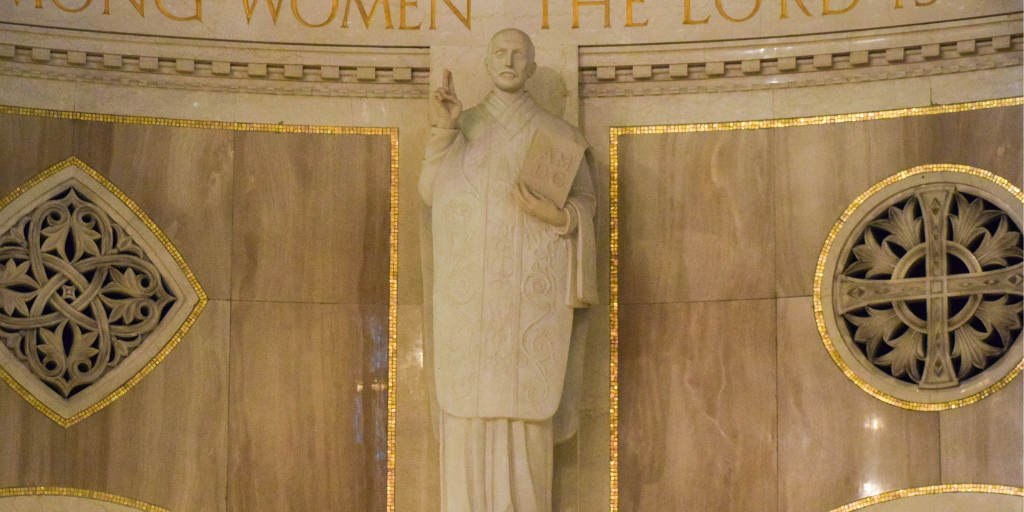
Before the battle of Pamplona, Ignatius of Loyola seemed destined for the glory of sword-flashing heroism.
The son of nobles, he was born in a castle and became a knight in his twenties. Despite his diminutive stature – a mere five feet and two inches – he was a proud man driven to develop his prowess in battle. As he rose to prominence in the Spanish military, the renown he dreamt of seemed imminent.
But when he suffered a debilitating injury at the battle of Pamplona, he learned his fighting days were over. To anyone else, it might have seemed like Ignatius’ life was ending; but in reality, it was just the beginning.

As we celebrate the Memorial of St. Ignatius of Loyola on July 31, we invite you to discover how this Spanish knight became a “knight for the glory of God” with five key facts from his life.
1. Ignatius was baptized in Spain as Inígo López de Loyola in 1491.
The youngest of 13 children, Inígo López de Loyola was born in a castle and became a page for the treasurer of Castile in 1506. It is unclear when he became known as Ignatius.
2. A cannonball left him with a lifelong injury.
After working as a page, Ignatius became a knight in 1517 and was a rising star in the Spanish military by age 30. However, during the battle of Pamplona, cannon fire wounded his leg and back, rendering him bedridden for an extended period of time. To make matters worse, the physician who initially tended him after his injury set his leg incorrectly, requiring the leg to be rebroken and set again. Though he was eventually able to walk again, he would always walk with a limp.
3. He was inspired to live in holiness after reading about the saints during his convalescence.
Following his injuries, Ignatius requested to read romances to fill the long hours of free time during his convalescence. However, he was informed that there were no romances available for him – only volumes on the lives of saints. Though tales of saints were not what Ignatius had hoped to immerse himself in, he found himself fascinated by their examples of faith and devotion. As he was a knight dedicated to a code of honor, the virtue of the saints likely inspired him. His reading sparked a journey that would lead him to an even higher code of honor: dedicating himself to be a “a knight for the glory of God.”
4. He is the author of the Spiritual Exercises.
Once Ignatius recovered sufficiently to walk, he decided to make a pilgrimage to the Catalonian shrine of Our Lady at Montserrat. There, he laid his sword and dagger on the altar after keeping an all-night vigil, searching for spiritual enlightenment. In the months that followed, he experienced a series of mystical visions as he continued to reflect. As he meditated, Ignatius began to write the work that would eventually be known as his Spiritual Exercises – a practical guide for meditation. Ignatius believed that it was necessary for daily meditation to be practical and consistent, remarking:
“In the same way that strolling, walking, and running exercise the body, spiritual exercises prepare the soul to become free of extravagant attachments and to discover what God wants to accomplish in one’s life.”
Ignatius’ Spiritual Exercises are still widely used by the faithful, with many attending four-week retreats modeled after the form conceived in the Exercises.

5. He founded the Jesuit Order.
In 1534, Ignatius joined with six friends from the university to form what would become known as the Society of Jesus, using his Spiritual Exercises as a framework for meditation. When the group was officially recognized by Rome in 1540, it consisted of just 10 members. Over the following 15 years, under Ignatius’ leadership as superior, it would expand to 1,000 members. The Society of Jesus, which eventually became known as the Jesuits, was dedicated to spreading Christ’s presence throughout the world, no matter how perilous the region. When St. Ignatius passed away in 1556, the presence of the Jesuits was scattered in nine countries and provinces in South America, Europe, and India. Today, the Jesuits have approximately 16,000 members around the world.
In the Basilica, St. Ignatius is portrayed in a Trani marble statue in the West Apse of the Great Upper Church, along with five other Jesuit saints. You can also find him depicted in the west façade.
Sources:
“Global Community,” The Jesuits Global.
“St. Ignatius of Loyola,” Britannica.
Butler’s Lives of Saints, ed. Bernard Bangley.
The Way of Saints, Tom Cowan.

